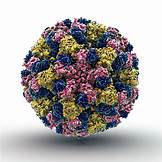Published on: November 15, 2021

NOROVIRUS
NOROVIRUS

NEWS
Norovirus outbreak in Kerala is being noticed
DETAILS
What
- Bug similar to the diarrhoea-inducing rotavirus
- Infects people across age groups
- Outbreaks typically occurs
Symptoms
- Vomiting and/or diarrhoea(one or two days after exposure to the virus)
- Patients also feel nauseous, and suffer from abdominal pain, fever, headaches and bodyaches
- Extreme cases, loss of fluids could lead to dehydration.
Treatment
- Self-limiting — the infection, even though it takes a lot out of the patient, normally lasts only two or three days, and most individuals who are not very young, very old, or malnourished can ride it out with sufficient rest and hydration.
- Diagnosis is done by real-time reverse transcription polymerase chain reaction. No vaccines are available for the disease
- Important to maintain hydration in the acute phase. In extreme cases, patients have to be administered rehydration fluids intravenously.
Transmission
- Highly contagious
- Can be transmitted through contaminated food, water, and surfaces
- Primary route is oral-faecal
- One may get infected multiple times as the virus has different strains
- Resistant to many disinfectants and heat up to 60°C
- Can also survive many common hand sanitisers.
How common
- Most common pathogen
- Implicated in outbreaks of gastrointestinal disease (inflammation of the stomach and intestines)
- The US Centers for Disease Control and Prevention estimates that about one out of every five cases of acute gastroenteritis worldwide is caused by Norovirus.
- There are 685 million cases annually, of which 200 million are detected among children younger than five years.
- Nearly 50,000 children die every year due to diarrhoea caused by the virus.
Prevention
- Repeatedly washing hands with soap
- Using the lavatory or changing diapers
- Surfaces must disinfected with a solution of hypochlorite at 5,000 parts per million.

